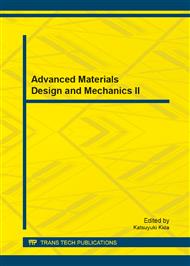p.512
p.516
p.522
p.528
p.533
p.538
p.543
p.547
p.555
Design and Analysis of Automotive Multi-Leaf Springs Using Composite Materials
Abstract:
One of the oldest suspension components that are still in use, especially in commercial vehicles, is leaf springs. Due to high strength to weight ratio, the automobile industries have shown interest in replacing steel springs with composite leaf springs. This work is carried out on multi leaf springs having nine leaves, used in commercial vehicle. A Finite element approach for analysis of a multi leaf springs using ANSYS software is carried out. The model is generated using solid works and imported in ANSYS. The material of the leaf springs is 65Si7 (SUP9), composite leaf springs and hybrid leaf springs. Fatigue analysis of leaf springs is carried out for steel leaf springs, and Static analysis for steel leaf springs, composite leaf springs and hybrid leaf springs.
Info:
Periodical:
Pages:
533-537
Citation:
Online since:
August 2013
Authors:
Price:
Сopyright:
© 2013 Trans Tech Publications Ltd. All Rights Reserved
Share:
Citation:


